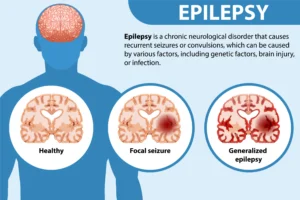 Epilepsy is a neurological disorder characterized by recurrent seizures, affecting millions of people worldwide.
Epilepsy is a neurological disorder characterized by recurrent seizures, affecting millions of people worldwide.
By understanding its causes, types of seizures, diagnosis, treatment options, and how to support those affected, we can better navigate the challenges associated with epilepsy and provide compassionate care to those living with the condition.
Today, we’ll explore epilepsy in detail, covering its causes, types of seizures, diagnosis, treatment, and how to support individuals living with this disorder.
Understanding Epilepsy
Epilepsy is a chronic disorder of the brain characterized by abnormal electrical activity, leading to recurrent seizures. Seizures can vary widely in their presentation, from brief lapses of consciousness to convulsions involving uncontrollable movements.
Causes of Epilepsy
- Genetic Factors. Some cases of this disorder have a genetic basis, with certain genes predisposing individuals to seizures.
- Brain Injury. Traumatic brain injury, stroke, brain tumors, and infections such as meningitis or encephalitis can damage the brain and increase the risk of developing this disorder.
- Developmental Disorders. Conditions such as cerebral palsy, autism spectrum disorder, and neurodevelopmental disorders may be associated with epilepsy.
- Infections. Infections affecting the brain, such as cysticercosis or toxoplasmosis, can trigger seizures and contribute to the development of this disorder.
Types of Seizures
- Generalized Seizures. Generalized seizures affect both sides of the brain and can cause loss of consciousness and convulsions. Examples include tonic-clonic seizures and absence seizures.
- Focal (Partial) Seizures. Focal seizures originate in a specific area of the brain and may cause localized symptoms such as muscle twitching, sensory disturbances, or altered consciousness.
Diagnosis of Epilepsy
- Medical History and Physical Examination. A healthcare provider will conduct a thorough medical history and physical examination to assess symptoms and potential risk factors for this disorder.
- Electroencephalogram (EEG). An EEG measures electrical activity in the brain and can help detect abnormal patterns associated with epilepsy.
- Imaging Studies. Imaging tests such as magnetic resonance imaging (MRI) or computed tomography (CT) scans may be performed to identify structural abnormalities or lesions in the brain.
Treatment Options
- Antiseizure Medications. Antiseizure medications are the primary treatment and work by stabilizing electrical activity in the brain. Examples include carbamazepine, lamotrigine, and valproic acid.
- Surgery. For individuals with seizures that are resistant to medication, surgery may be an option to remove or disconnect the area of the brain responsible for seizures.
- Vagus Nerve Stimulation (VNS). VNS involves implanting a device that delivers electrical impulses to the vagus nerve, helping to reduce seizure frequency and severity.
Supporting Individuals With This Disorder
- Education and Awareness. Educate yourself and others about this disorder to reduce stigma and promote understanding.
- Safety Precautions. Help individuals with epilepsy identify and minimize triggers for seizures, and provide support during and after seizures.
- Access to Resources. Connect individuals with this disorder to support groups, advocacy organizations, and healthcare professionals specializing in epilepsy care.
Epilepsy is a complex neurological disorder that can significantly impact individuals’ lives. Understanding epilepsy is essential for recognizing its symptoms, managing the condition, and providing support to those affected. If you or someone you know is affected by epilepsy, consult a healthcare professional for personalized evaluation and management.
Picture Credit: Freepik
